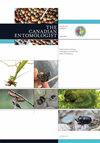Effects of Sublethal doses of Chlorfluazuron on the Biochemical Constituents of Eggs of Spodoptera litura (Lepidoptera: Noctuidae)
IF 1.1
4区 农林科学
Q3 ENTOMOLOGY
引用次数: 4
Abstract
Abstract The effects of sublethal doses (LD10: 1.00 ng/larva; LD30: 3.75 ng/larva) of chlorfluazuron on the biochemical constituents of eggs of the tobacco cutworm, Spodoptera litura (F.), are described. Chlorfluazuron was applied topically to fifth-instar larvae and the subsequent adults were allowed to mate according to larval treatment (LD10-treated female × LD10-treated male and LD30-treated female × LD30-treated male). Biochemical constituents of eggs resulting from these pairings were analyzed at various stages of embryonic development. Compared with controls, LD10 or LD30 reduced egg constituents as follows: protein (min.—max.) by 32.8%–34.5% or 62.0%–67.3%, lipid by 33%–34% or 62%–67%, carbohydrates by 30%–39% or 60%–67%, DNA by 33%–40% or 60%–69%, RNA by 31%–34% or 59%–67%, and ecdysteroid by 22%–83% or 28%–92%, respectively. The relative proportions of constituents in control eggs were as follows: protein > lipid > carbohydrate, and RNA > DNA. Three low and three high peaks in ecdysteroid titres were observed. Compared with controls, all peaks were reduced in LD10 or LD30 eggs as follows: low peaks: 1st (at 8 h): 32% or 66%; 2nd (at 16 h): 33% or 67%; 3rd (at 52 h): 35% or 65%; high peaks: 1st (at 32 h): 83% or 92%; 2nd (at 64 h): 65% or 82%; 3rd (at 84 h): 84 h, 36% or 63%, respectively. In addition, the first two high peaks were delayed by 4 h in LD10 eggs and by 8 h in LD30 eggs compared with controls. Sublethal doses of chlorfluazuron reduced the amounts of biochemical constituents of eggs during embryogenesis in S. litura.亚致死剂量氯氟脲对斜纹夜蛾卵生化成分的影响
亚致死剂量(LD10: 1.00 ng/幼虫;描述了氟唑脲对斜纹夜蛾虫卵生化成分的LD30: 3.75 ng/幼虫)。5龄幼虫局部施用氯氟脲,按处理方式(ld10处理雌× ld10处理雄、ld30处理雌× ld30处理雄)进行交配。在胚胎发育的不同阶段分析了这些配对产生的卵子的生化成分。与对照组相比,LD10或LD30分别使鸡蛋的蛋白质(min.-max .)降低32.8% ~ 34.5%或62.0% ~ 67.3%,脂质降低33% ~ 34%或62% ~ 67%,碳水化合物降低30% ~ 39%或60% ~ 67%,DNA降低33% ~ 40%或60% ~ 69%,RNA降低31% ~ 34%或59% ~ 67%,外甾体激素降低22% ~ 83%或28% ~ 92%。对照蛋中各成分的相对比例为:蛋白质b>脂质>碳水化合物b> DNA。外皮甾体滴度有3个低峰和3个高峰。与对照组相比,LD10或LD30卵的所有峰值均降低如下:低峰:第1 (8 h): 32%或66%;第2次(16小时):33%或67%;第三(52小时):35%或65%;高峰:第1峰(32 h): 83%或92%;第二次(在64小时):65%或82%;第三名(84小时):84小时,分别为36%和63%。LD10卵和LD30卵的前两个高峰分别比对照推迟了4 h和8 h。亚致死剂量氯氟脲可降低斜纹夜蛾胚胎发生过程中卵生化成分的含量。
本文章由计算机程序翻译,如有差异,请以英文原文为准。
求助全文
约1分钟内获得全文
求助全文
来源期刊

Canadian Entomologist
生物-昆虫学
CiteScore
2.20
自引率
11.10%
发文量
24
审稿时长
6-12 weeks
期刊介绍:
French translation follows/le français suit Published since 1868, this peer-reviewed bimonthly publication is the official journal of the Entomological Society of Canada. Available via the internet and with hardcopy distribution to 55 countries, its research papers and notes are relevant to entomologists and other biologists around the world. In addition to being a venue for topical reviews and forum discussion, The Canadian Entomologist publishes current research in all facets of entomology, including systematics and morphology, molecular and developmental biology, ecology and behaviour, biodiversity and evolution, insect management, entomological techniques, and other relevant subject areas. Contributions are published in English or French. Authors will not pay page charges, and will experience fast, high quality reviews of their papers.Publiée depuis 1868, cette publication bimestrielle avec comité de lecture est la revue officielle de la Société d’entomologie du Canada. Disponible sur Internet et distribuée en format papier dans 55 pays, ses articles de recherche et ses notes sont pertinents pour les entomologistes et autres biologistes de par le monde. En plus d’être une plate-forme pour des revues thématiques et un forum de discussion, The Canadian Entomologist publie la recherche actuelle sur toutes les facettes de l’entomologie, incluant la systématique et la morphologie, la biologie moléculaire et développementale, l’écologie et le comportement, la biodiversité et l’évolution, la gestion des insectes, les techniques entomologiques et d’autres domaines pertinents. Les contributions sont publiées en français ou en anglais. Les auteurs ne paient aucun frais de publication, et recevront une révision rapide et de grande qualité de leurs articles.
 求助内容:
求助内容: 应助结果提醒方式:
应助结果提醒方式:


